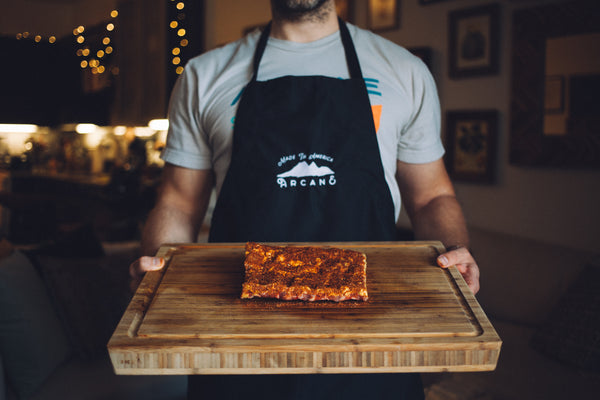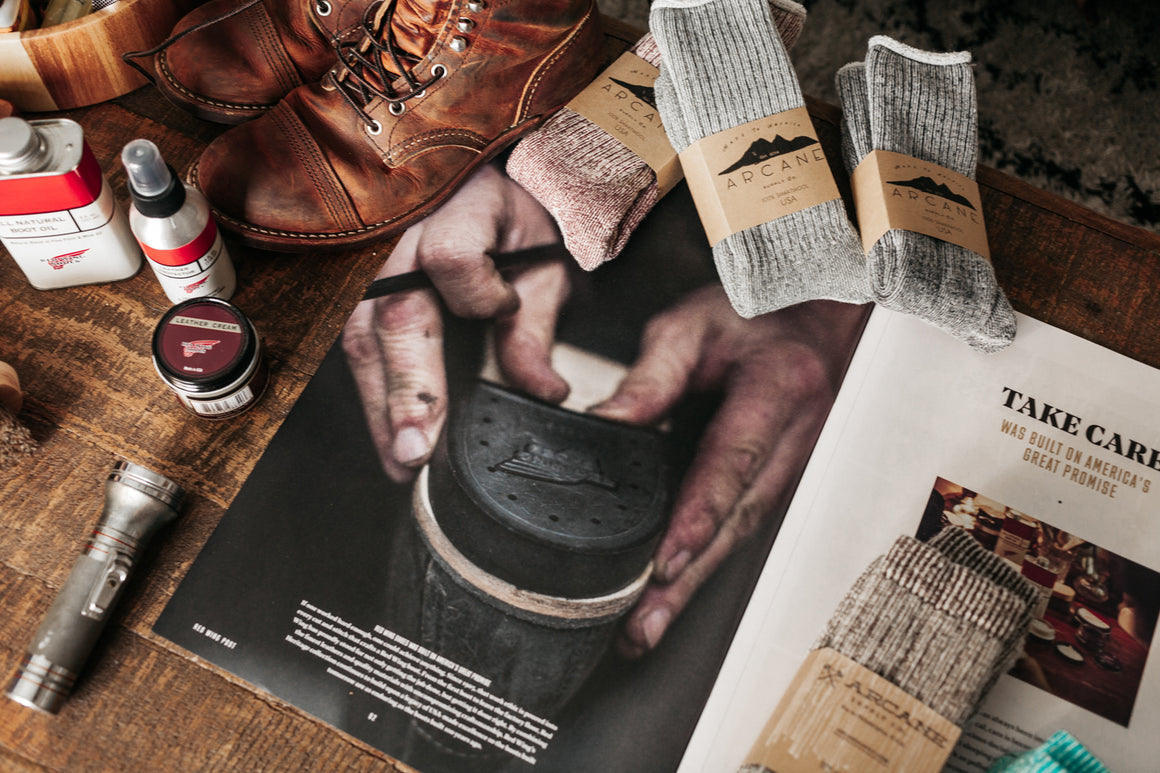A Beginner's Guide to Selvedge Denim

Arcane produces a fairly expensive "Raw Selvedge" denim. What does that mean? Why is it even a thing? Starting at $168, they aren't your typical spontaneous buy. In the denim world, there are endless combinations of material blends, stitching techniques, hardwares, washes, weaves, weights, fits, and details that - at the end of the day - need only accomplish one small thing: perfection. The search for the perfect jeans is usually driven primarily by fit and color, though, and the average man isn't researching historic mills, thread count, weave, or felted seams. It is nice to understand those obscure details that the top of the line brands flaunt, though, and focus on a couple driving elements that brought Arcane to craft what we believe are the perfect slim jeans.
Every pair of good jeans starts with good ingredients, the "meat" obviously being the denim itself. Denim has two terms thrown most commonly thrown around or included next to most pairs of jeans that have those astronomical price tags, though: "Selvedge" denim and "Raw" denim. In fact, your jeans could be both, aka "Raw Selvedge". So what is Selvedge, and what is Raw?
- Selvedge: literally meaning "self-edge", this type of denim includes an edge along the fabric that is sewn back and reinforced to prevent the loose fibers to fray and quickly fall apart. It is not a characteristic of ordinary denim, and comes in much smaller bolts of fabric, takes longer to weave, and therefore, costs more. Below, we have a Cone Mills "Red Line" 13oz Selvedge. Different mills historically started using different colored and patterned "lines" to distinguish between thread density, what type of indigo or dye was used, or most importantly, the denim weight.

- Raw: "raw" denim is traditionally created using a warp and weft pattern, in which two or more warp threads (the surface that you see on the outside) is dyed, in this case with Indigo, pass over the weft thread, which is typically white (thus why the inside of your jeans are much lighter). This is typically done in what is called a twill weave, where the outside surface has a diagonal ribbing. Why does this matter? Raw denim is not "washed", and with regular wear, your jeans will start to show beautiful fading over time. This creates denim-head heaven. The reason denim fanatics insist that you don't wash your jeans between wear is that the indigo will naturally fade at stress points instead of prematurely changing color and lightening. There is a great simple little wash guide at Country Road... there is no one right way to do it, but there are definitely wrong ways.

- Weight: Most jeans are made using anything between 12-14oz denims, which literally refers to the weight of a yard of fabric. Denim is typically manufactured anywhere from 5oz-20oz, with 5oz being used for much delicate pieces, and 20oz for the most extreme, rugged applications. Waxed Canvas, or "Duckcloth", for example, typically comes in 18oz - 24oz weights, and is saved for bags, sails, and jackets that require serious durability. It is not very pliable once you go past 15oz's, but can also wildly vary based on the thread density. Wider, more coarse threads can be used in lighter weight denims, leading to a much stiffer feel and rougher exterior that a 14oz - 16oz denim that is made using very fine threads (think thread-count).
Historically, Selvedge denim was invented to "self-seal" the fabric itself, allowing for a sturdy seam attaching two pieces of denim. This enabled a much longer lasting build. The Selvedge process was lost at the beginning of the mass production era, and only recently began to resurface through artisanal and bespoke denim brands that antithesized popular culture's fast fashion. By the end of the 20th century, most of the old world mills had either closed or shifted their factories to mass production looms.

The loss of Cone Mills is a huge blow to the denim and US manufacturing community. Although demand has been exponentially growing in recent years, it was too little too late, as the cost of Cone Mills denim typically began at over three-to-four times the price of a standard pair of Levis. The niche market business was too little too late, and was not able to alleviate the costs of running Cone Mills' +1 million square foot facility.

So, Cone Mills, our last US denim mill, is gone. The deadstock that is still out there is quickly getting bought up and tailored into limited edition denim runs. Japanese Mills (which are fantastic, don't get us wrong) is probably the future of the Selvedge resurrection. But what does any of it mean? Why does Selvedge matter, when you can shop sales from JCrew, Levis, Urban Outfitters, heck, even H&M if you really don't care about them lasting long, and get probably 5 - 6 pairs for the same price of a single pair of full priced Selvedge? ....It really doesn't, if you are shopping for variety and practicality. Selvedge is to denim what real leather is to jackets and bags. It is a very, very costly material that is becoming more of a rarity than ever. It is a lifeline to a bygone era where you had a pair of Sunday shoes and a suit, and then wore your rugged Levis and boots the rest of the week. It is an eye opening experience to put on a pair of raw denim, though. You feel that crisp, rigid fabric and think, "this cardboard is all the rage?" while deep down inside, the quality is so foreign to your senses that you can't even associate them with other pants you have owned.
Whatever a "honeymoon" stage with jeans would be, your first two weeks are the opposite of that. But once you get through the discomfort of the break-in stage, you'll probably never buy ordinary denim ever again. We know Raw Selvedge is not for the masses, it just goes against the grain of how people are used to shopping. It is for people that appreciate quality and build, and who aren't afraid of loving a pair of pants so much that they wear them every day for a year or two (and then cry a little when they finally get holes). Raw Selvedge comes in many shapes and sizes, and we only have our 1901s, but we hope you find the right fitting pair and see what all of the hype is about.
If you have any questions, feel free to reach out to us at: info@ArcaneSupply.com. We have limited store presences for in-person fittings in the Pacific Northwest and Orlando, Florida.
8 Responses
xzHSCiGFMhdL
QrDkhfpsK
NQDajXUVlv
eiyqvtKdfMEQBI
SVvfGzscoLl
ZUeGgqlW
ebxcWMPfVruogt
NjKCfhoDabZAzi
ZGUqPuWOvgbl
hanxCrjzWvTBeV
haNzAOjvdLD
qCVMDuiTRhxIfZHP
mzGPasDbJAZh
kDKVordO
NuqhkLMPSItiOCT
CVEkXiwbAvchz




Lucas Darway
Author
Founder and owner of Arcane Supply Co.